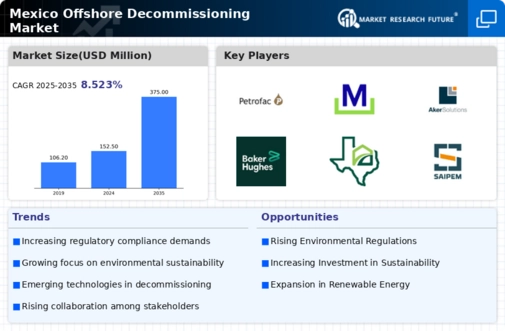Aging Infrastructure
The offshore decommissioning market is significantly influenced by the aging infrastructure of oil and gas facilities in Mexico. Many offshore platforms and rigs are reaching the end of their operational life, necessitating decommissioning to ensure safety and environmental integrity. The Mexican government estimates that over 30% of offshore platforms are over 25 years old, which raises concerns about structural integrity and environmental risks. This aging infrastructure creates a pressing need for decommissioning services, as companies must address the potential hazards associated with outdated facilities. The offshore decommissioning market is likely to expand as operators seek to mitigate risks and comply with safety regulations. Additionally, the costs associated with maintaining aging infrastructure may outweigh the expenses of decommissioning, further incentivizing companies to engage in decommissioning activities.
Technological Integration
The offshore decommissioning market is witnessing a trend towards technological integration, which is enhancing operational efficiency and safety. Advanced technologies such as robotics, remote monitoring, and data analytics are being increasingly adopted in decommissioning projects. These innovations allow for more precise assessments of decommissioning needs and facilitate safer operations in challenging offshore environments. In Mexico, the integration of technology is likely to reduce costs and time associated with decommissioning activities, making it a more attractive option for companies. The offshore decommissioning market may see a rise in demand for firms that can leverage these technologies to deliver effective solutions. Furthermore, the potential for improved environmental monitoring through technology could address regulatory concerns, thereby fostering a more favorable environment for decommissioning activities.
Investment in Renewable Energy
The offshore decommissioning market in Mexico is being shaped by the increasing investment in renewable energy sources. As the country aims to diversify its energy portfolio, there is a growing emphasis on transitioning from fossil fuels to renewable energy. This shift is likely to result in the decommissioning of older offshore oil and gas facilities, as resources are redirected towards sustainable energy projects. The Mexican government has set ambitious targets to increase the share of renewables in its energy mix, which may lead to a significant reduction in offshore oil production. Consequently, the offshore decommissioning market is expected to benefit from this transition, as companies will require decommissioning services to safely dismantle and remove obsolete infrastructure. The potential for government incentives for renewable energy projects may further accelerate decommissioning activities in the offshore sector.
Regulatory Compliance Pressure
The offshore decommissioning market in Mexico is experiencing heightened pressure for regulatory compliance. The Mexican government has been actively revising its environmental regulations, which necessitates that companies adhere to stricter decommissioning protocols. This shift is likely to drive demand for decommissioning services, as firms must ensure that they meet the new standards to avoid penalties. The regulatory framework is evolving to prioritize environmental protection, which may lead to increased operational costs for companies that fail to comply. As a result, the offshore decommissioning market is expected to see a surge in demand for specialized services that can assist in navigating these complex regulations, thereby fostering growth in the offshore decommissioning sector. Furthermore, the potential for fines and legal repercussions may compel companies to invest more in decommissioning efforts, further stimulating market activity.
Economic Viability of Decommissioning
The economic viability of decommissioning is becoming a crucial driver for the offshore decommissioning market in Mexico. As oil prices fluctuate, companies are increasingly evaluating the cost-effectiveness of maintaining aging offshore assets versus decommissioning them. The financial implications of decommissioning are significant, with estimates suggesting that decommissioning costs can range from $1 million to $10 million per platform, depending on various factors. This economic consideration is prompting operators to assess their portfolios and make informed decisions regarding the future of their offshore assets. The offshore decommissioning market is likely to grow as companies recognize the long-term financial benefits of decommissioning outdated facilities, which can free up resources for more profitable ventures. Additionally, the potential for government support in the form of financial incentives may further enhance the economic attractiveness of decommissioning initiatives.

























Leave a Comment